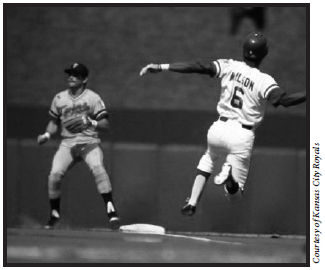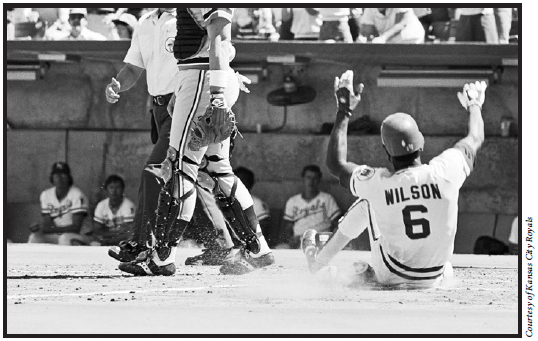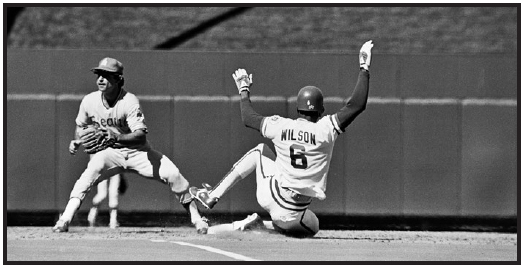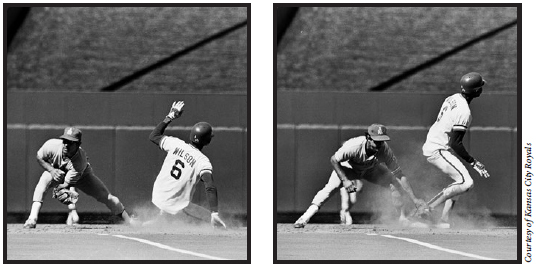
I didn’t really think about trying to stretch singles into doubles because I always considered my singles were doubles. I was going to steal second. What I was trying to do was cause havoc by splitting the pitcher’s brain in half between the batter and me – and mostly thinking about me. If I’m on first, your brain is thinking I don’t want him to get to second. He’s going to do all these throws, then, BOOM, Somebody else gets a home run or somebody gets a double.
If I’m on first, I can score on a double every time.
I never really tried to get a big lead because I didn’t want guys throwing over a whole heck of a lot. If they throw over, I have to retreat to first base. If I took a big lead, I had to dive back. If you are diving, you’re always diving on your chest and I didn’t want to do that.

I always slid on my right side when I was stealing a base because if the ball got by the fielder I could see where it went.
At Royals Stadium, I had one foot on the turf and one on the dirt. I knew if I was at that place I could take one giant step and be back. But pitchers knew even if I didn’t have a big lead I can still steal second. So, right there you are already in their brain. That spot was about three-and-a-half shuffles. I would never walk out to my lead, I’d take these sideways shuffles. You don’t walk because if your foot is off the ground and he makes the throw, you can’t get back.
I would shuffle, shuffle, shuffle. Three-and-a-half slides and I knew I was at my spot.
When I was going to steal I would take my first step with my left foot, closest to first. I had to teach myself how to get off quickly because it was always a struggle to go to my right. After my shuffle, I would drop my right foot just a little behind my left. That opened up my hips a little bit so I could just go straight across my body with my left leg.
I would take my right arm and pull it down as hard as I could and then just go. I never really worked on it, but it was like a sprinter would take off. When I did that ... one step ... two step ... and at about the third step I peeked a glance toward the catcher. By then the ball is already there so you can see whether the catcher caught it cleanly and how quickly he might be able to get off a throw. I never really worried about the catcher because I never thought a catcher could throw me out. We had timed everything, and you knew the pitcher took two-something seconds to get the ball to home plate, the catcher took one-something getting the ball out of his glove. So, you would have about three seconds or so to steal the base.
If I had to slide I would always slide on my right side, never on the left. The reason? I don’t know whether it was a conscious decision or not, but if there was an overthrow, I could see how far the ball went into the outfield and get up and go to third. If I slid on the left I was looking toward the infield, and the ball is back behind me. People could be yelling, “Go! Go! Go!” But by the time you find the ball it’s too late to take another base. Another reason is I tried it once my rookie year on my left side, and I sprained my ankle.
Learning how to read the pitchers is something Amos Otis really schooled me on. When I came up we had a lot of guys who could run. Amos, Cookie Rojas, Al Cowens, Freddie (Patek), Davey Nelson. Our catcher, John Wathan, had 30 stolen bases one year. Those guys were base stealers. Amos, after he accepted me, was really good about teaching me. He was really hard on me at the beginning of my career because I think he thought I was coming in to take his spot, but it turned out he was really helpful. Besides all the center field stuff he taught me, he also taught me about stealing bases.
The best advice he gave me about stealing was, “Never sit close to the manager.”
I asked, “Why? I want to learn some manager stuff.”
He said, “If you are going to learn about stealing bases you sit at the end of the bench because that’s the best angle to see the pitcher throwing to first. You watch that pitcher from the top, and you watch him all the way down to the end. You tell me exactly what he does different when he comes to first than when he goes home.”
So, I’m sitting there one day, watching, and AO goes, “You see that?”
I’m saying, “What?”
He says, “There, see that little wrinkle in his pants. When his pants do something like that he goes home every time.”
I’m thinking, “Oh man, this is going to be tough.” I never even saw it.
After he points it out, I can see it easy. Then he said, and I don’t know if he was joking or not, but he says, “I’m going to steal a base standing up on that guy. He stole five bases, two standing up that day.” That’s when I really started sitting there and watching guys and watching what they would do.

Sliding into home was one of the favorite things to do because it meant another run for the Royals.
I had to do that because stealing bases was not something that I ever did much of before I turned pro. I stole bases in high school, but that wasn’t a real focus. I was a catcher. I had a good arm, but nobody really talked about my speed in high school.
I got to the minors with the Royals rookie league team in Sarasota, and I really wasn’t hitting all that well. Because I didn’t hit well I felt like I had to do something else to be noticed. So, I started stealing bases. As you start stealing bases you realize that because you are stealing bases and getting in scoring position you are helping everybody else out – the No. 2 man, the No. 3 man, the No. 4 man.
The guys with the big league team knew I was fast and could steal, but they wanted me to concentrate on switch-hitting. When I got to AAA I knew I had to do something to stand out. That’s what I tell the young guys now who are getting my award for base running: If the best guy is at 40 or 50, you want to be at 79 or 80. You want them to go, WOW, this guy can really run. So, that’s what I tried to do.
I really wanted to learn to hit because the way to steal more bases was to get on base. The thing they kept saying to me was, “You can’t steal first. You can’t steal first.” The reason they kept saying that was because I wasn’t really hitting. When I got to AAA I was really going to give it a shot. I was getting too close.
The key to stealing bases, you have to have a short-term memory like a relief pitcher. Relievers go into the game in the ninth, two outs and they give up a run that loses the game. Just like stealing, you get thrown out, but you have to keep going. If you don’t keep going that takes away part of your artillery.
Stealing is hard on your body. I mean, who likes to go out there and run as fast as you can, then jump out of a car at about 20 miles an hour on some really hard dirt? In those days you didn’t have the really good pads the way they have now. We had just two pads on each side, and you had a little string and tied them up. They would roll up and get bunched up, no protection at all.
After I was up in the majors a couple of years, I didn’t steal as much anymore because it actually would have hurt the team. Stealing bases, you just have to have the mentality of just go, go, go. One day, I was out there jumping around at second base, and the funniest damn thing happened.


STOLEN BASE |
DATE |
OPPONENT |
PITCHER |
1 |
Sept. 9, 1976 |
Vs. California |
Mike Overy |
100 |
Aug. 3, 1979 |
At Detroit |
Pat Underwood |
150 |
May 19, 1980 |
Vs. Oakland |
Steve McCatty |
200 |
Sept. 12, 1980 |
At Oakland |
Rick Langford |
250 |
Sept. 29, 1981 |
At Minnesota |
Albert Williams |
300 |
May 1, 1983 |
Vs. Cleveland |
Lary Sorenson |
350 |
May 26, 1984 |
At Boston |
Roger Clemens |
400 |
May 22, 1985 |
At Texas |
Dickie Noles |
450 |
June 5, 1986 |
Vs. Minnesota |
Roy Lee Jackson |
500 |
July 25, 1987 |
At Baltimore |
Dave Schmidt |
550 |
July 31, 1988 |
At Baltimore |
Jose Bautista |
600 |
June 13, 1990 |
At California |
Mike Fetters |
650 |
July 19, 1992 |
Vs. Detroit* |
Kevin Ritz |
668 |
April 8, 1994 |
At Montreal** |
Jeff Shaw |
* With Oakland Athletics; ** With Chicago Cubs
Hal McRae is at bat and he calls time out. He yells out to me, “Stand still!”
He’s yelling at me. He’s telling me to stand still. I look at him and go, “What?” He yells, “The ball’s white. The uniform is white. It’s getting lost in the uniform. Just stand still.”
Then he goes, “I’ll get you in.”
The pitcher looks at him crazy, and I think, “Oh crap, he didn’t just say that.” The next pitch, of course, knocks him down. He just gets up and does his thing and puts the ball in right field and I score.
Another reason I didn’t steal a lot was because of George (Brett). I remember we were playing at Detroit all the time and Sparky Anderson was their manager. Sparky would always say we don’t want Willie and George to beat us ... but he would say, “George and Willie.” That just made me angry because I tried so hard to beat them.
But if I get on base and steal second, they walk George – especially if there are two outs. So, I would sit there and say to myself, “Hit a double, George and I’ll score. Hit a double.”
Sometimes on lefties I would just take off. I wouldn’t even know their move.
(Ron) Guidry was the easiest guy in the world to steal off. When he wanted to go home with the ball he would duck his chin. When he wanted to go to first his head would stay dead still. See, he was a power pitcher. When you are a power pitcher you want to get everything into your body so you tighten up and muscle up for the pitch. His chin would tuck down, and as soon as he does that I’m, “Whoosh!” The key against him was getting on base. That was the hard part. You had to get on, but once you got on, you could steal on him easy.
My first stolen base came when I went into the game as a pinch runner for John Mayberry in the bottom of the ninth. The pitcher was Mike Overy.